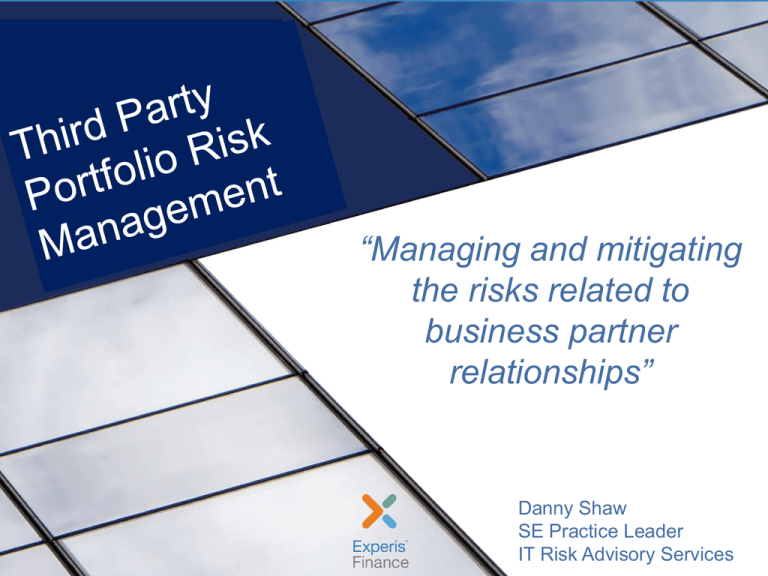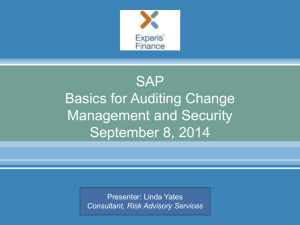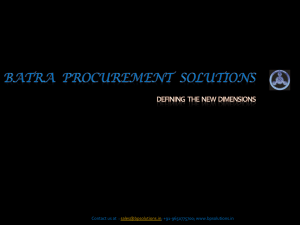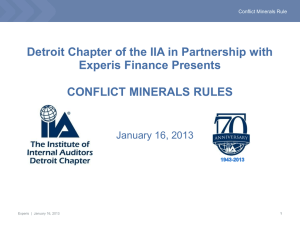Managing 3rd Party Risks
advertisement

Managing 3rd Party Risks During a Crisis “Managing and mitigating the risks related to business partner relationships” Experis | , June 2013 Danny Shaw SE Practice Leader 1 IT Risk Advisory Services Managing 3rd Party Risks During a Crisis “A management team cannot claim to be in Why do we care ….. control of its business if it is not in control of the There’s a lot of $$$ contracts the business depends on. involved! What is more, any business that seeks • 95% of organizations buy or competitive advantage must be committed to provide outsourcing services improving the performance of its procurement function.” • 75% of organizations spend Gartner Research, Six to Better Procurement Contract Management upwards of 50% of Keys their budgets on outsourcing Experis | , June 2013 2 Managing 3rd Party Risks During a Crisis Objectives: Organizations frequently rely upon 3rd party service providers to deliver a wide variety of services and other activities. The “What” is your responsibility These arrangements may result in activities being outsourced in their entirety, but they do not relieve the ‘hiring’ organizations of the responsibility for managing the activities and identifying/controlling the risks associated with the relationships. Learning Objective 1: • Gain an understanding of the potential risks that may arise from the use of 3rd party service providers Learning Objective 2: • Identify the basic elements of an effective 3rd party risk management program Experis | , June 2013 3 Managing 3rd Party Risks During a Crisis Vendor Risk Management Process • The use of a 3rd party service provider reduces management’s direct control over the activities at hand, but therefore increases the need for oversight of the activities from start to finish. – The key to the effective use of a 3rd party in any capacity is for the organization to appropriately assess, measure, monitor and control the risks associated with the relationship. Experis | , June 2013 4 Managing 3rd Party Risks During a Crisis Why do we care ….. There’s a lot of $$$ involved! • 95% of organizations buy or provide outsourcing services • 75% of organizations spend upwards of 50% of their budgets on outsourcing Experis | , June 2013 5 Managing 3rd Party Risks During a Crisis 2013 Global Outsourcing Market for IT, BPO and call center services ALONE is $450B – Who’s minding your assets? U.S. Government spends $550 billion annually on outsourced products and services Experis | , June 2013 6 Managing 3rd Party Risks During a Crisis CASE STUDY: Experis | , June 2013 Boeing 787 Dreamliner 7 Managing 3rd Party Risks During a Crisis A complex, integrated, interconnected environment Supply chain issues + new technology + new approach = PROBLEMS • Made of entirely new composite material • 6,000 engineers • 43 “top tier” suppliers on 3 continents • 80% of production outsourced • Exacting technological demands • Overly ambitions production deadlines Experis | , June 2013 8 Managing 3rd Party Risks During a Crisis The result? • Plane delayed by 2+ years • Upwards of $6 billion in lost profits • Millions in contract penalties for late delivery • Reputation took a “hit” Without collaboration and measurement the 300 year old parable still applies: of THE BLIND MEN AND THE ELEPHANT Experis | , June 2013 9 Managing 3rd Party Risks During a Crisis Top 5 Reasons Organizations Outsource 75% Reduce and control operating costs 65% Focus on core competencies 59% Resources not available internally 52% Reduce internal headcount 51% Reallocate internal resources for higher value purposes Experis | , June 2013 10 Managing 3rd Party Risks During a Crisis Top 5 Functions Outsourced 69% IT (all categories) 29% Operations and administration 26% Customer service 21% Other (wide variety) 20% Financial (payroll, etc.) Experis | , June 2013 11 Managing 3rd Party Risks During a Crisis Third-Party Arrangements - WHY? • Appropriately managed 3rd-party relationships can: – Enhance competitiveness, – Provide diversification and – Help organizations to attain key strategic objectives. – FASCILITATE Business Continuity – They can facilitate an increase in revenue or a reduction of costs. However, these business arrangements can also present risks to the organization. • The board of directors and senior management are ultimately responsible for – managing activities conducted through 3rd-party relationships – as well as identifying and controlling the risks arising from such relationships. Experis | , June 2013 12 Managing 3rd Party Risks During a Crisis Cloud Based 3rd-Party Arrangements • Global cloud services revenue projected to reach – $149B by 2014 and – $241B by 2020. • Information Security nightmare or an enabler for cloud adoption, with recent increases in highly publicized cloud security breaches. Experis | , June 2013 13 Managing 3rd Party Risks During a Crisis Potential risks arising from 3rd-party relationships • 3rd party risk is not a simple, easily identifiable risk attribute, but rather a combination of risks ranging from the familiar to the highly complex. • Such risks can vary greatly, depending upon the specific characteristics of each third-party arrangement. • Risks Relationships are Associated as the following: – Strategic – Reputational – Operational – Transaction – Credit – Compliance Experis | , June 2013 14 Managing 3rd Party Risks During a Crisis Strategic Risk The risk arising from adverse business decisions, or the failure to implement appropriate business decisions in a manner that is consistent with the organization’s strategic goals. Experis | , June 2013 15 Managing 3rd Party Risks During a Crisis Reputation Risk The risk arising from negative public opinion. – 3rd Party relationships that result in • dissatisfied customers, • inappropriate recommendations, • security breaches resulting in the disclosure of sensitive information and violations of laws and • regulations are examples of situations that could create negative publicity and harm the reputation of the business. Experis | , June 2013 16 Managing 3rd Party Risks During a Crisis Operational Risk The risk of loss resulting from: inadequate or failed internal processes, people, and systems, or from external events. – 3rd Party relationships often integrate the process of other organizations with the internal processes of the business and can thereby increase the overall complexity of the operational environment. Experis | , June 2013 17 Managing 3rd Party Risks During a Crisis Transaction Risk The risk arising from problems with service or product delivery. – A 3rd-party’s failure to perform as expected due to: – inadequate capacity, – technological failure, – human error or fraud exposes the entity to transaction risk. – lack of effective BC / DR plans – a weak IT internal control environment that threatens the integrity of systems and resources. Experis | , June 2013 18 Managing 3rd Party Risks During a Crisis Credit Risk The risk that a third party, or any other creditor necessary to the third-party relationship, is unable to meet the terms of the contractual relationship. – Solvency? The basic form of credit risk involves the financial condition of the service provider itself. – Peak Demand? A crisis can stress the abilities of your provider. Can they handle peak demands? Experis | , June 2013 19 Managing 3rd Party Risks During a Crisis Compliance Risk The risk arising from violations of laws, rules or regulations, or from noncompliance with internal policies, procedures or business standards. – Compliance risk is exacerbated when the organization has inadequate oversight, monitoring or audit functions. – Does your provided have an SSAE16 SOC1, 2 or 3 that addresses your organization’s specific control requirements? Experis | , June 2013 20 Managing 3rd Party Risks During a Crisis Manage 3rd-Partys throughout the “Vendor Lifecycle” “Leading Practice” Attributes Lifecycle stage 1. Discovery Pre-screening, market research, background checks 2. Selection Involve cross-functional team (procurement, legal, audit, compliance, IT, Security, business process owners) Due diligence information gathering Apply risk-adjusted value measurement and weighted criteria Utilize standardized risk-based vendor checklists Assign risk identification and evaluation tasks to control owners 4. Risk Assessment Apply vendor screening criteria, risk classification, mitigation, and remediation steps to each vendor. 5. Performance Measurement 6. Performance Monitoring Develop vendor-specific KPIs, scorecards, and benchmarking metrics to measure performance and adherence to contractual requirements Ongoing vendor risk and score performance Proactive mitigation of issues Validate compliance and fulfillment of terms Utilize standardized, risk-driven vendor audit programs conducted periodically to reduce risk and drive compliance Identify and address risks within 3rd party attestation reports Perform additional internal or external procedures to reduce or mitigate risks 21 Terminate relationship and exercise applicable clauses 3. Contract initiation 7. Auditing Experis | , June 2013 8. Decommission Managing 3rd Party Risks During a Crisis Risk Assessment Key Components • Develop specific business requirements: • What do we need? – When do we need it? – How do we pay for it? – How will we know if we got what we paid for? • Develop a thorough understanding of: • What the proposed relationship will accomplish and • Why the use of a 3rd party is in the organization’s best interest • Analyze the benefits • costs, legal aspects & potential risks • Perform a risk/reward analysis for significant matters, • Compare the proposed 3rd-party relationship to other methods of performing the activity: the use of other vendors, performing the activity in-house, etc. • Identify performance criteria • internal controls, reporting needs and contractual requirements. Experis | , June 2013 22 Managing 3rd Party Risks During a Crisis Due Diligence in Selecting a Third Party • The scope and depth of the due diligence activity should be directly related to the significance and magnitude of the anticipated relationship with the third party. • Not only should the due diligence be performed prior to selecting a 3rd party, but also periodically throughout the duration of the relationship. • Comprehensive due diligence involves the review of all available information concerning a potential 3rd party, • focusing upon the entity’s financial condition, • its specific relevant experience, its reputation and • the scope/effectiveness of its operations & controls. Experis | , June 2013 23 Managing 3rd Party Risks During a Crisis Due Diligence Review • • • • • • • Audited financial statements Experience & capabilities in the proposed activity Business reputation Qualifications/experience of the company’s principals Existence of significant complaints, litigation or regulatory actions Use of other parties or subcontractors Scope of internal controls, systems & data security, audit coverage • Business resumption strategy & contingency plans • Adequacy of management information systems • Insurance coverage Experis | , June 2013 24 Managing 3rd Party Risks During a Crisis Contract Structuring & Review • Management expectations should ensure that the specific obligations of both parties are outlined in a written contract prior to entering into the arrangement. • Board approval should be obtained prior to entering into any significant third-party arrangements. • Legal counsel should review significant contracts prior to finalization. • Contract should prohibit assignment, transfer or subcontracting of obligations to another entity. Experis | , June 2013 25 Managing 3rd Party Risks During a Crisis Content of the Contract • • • • • • • • • • • • Scope Compliance (SOX, HIPAA, PCI, GLBA, NERC/FERC, etc.) Cost/compensation Insurance / Cyber-Insurance / Cyber-Liability Performance standards Management information reports, 3rd Party Attestations “Right to audit” Confidentiality, Security, and Data Ownership Business resumption and contingency plans Default & termination Dispute resolution Indemnification, Limits on Liability Experis | , June 2013 26 Managing 3rd Party Risks During a Crisis Oversight of 3rd-Party Activities • Management should periodically review the 3rd party’s operations • Verify that they are consistent with the terms of the written agreement and that risks are being controlled. • Management should consider designating a specific officer to: • coordinate the oversight activities with respect to significant relationships and, as necessary • involve other operational areas (audit, IT) in the monitoring process. • An effective oversight program will generally include • the monitoring of the third party’s quality of service, risk management practices, applicable internal controls and reports Experis | , June 2013 27 Managing 3rd Party Risks During a Crisis Technology Enablers Vendor management solutions can provide strategic advantages, as well as process efficiencies. Some of these key features include: • Automated workflow – routing processes such as review, approval, and alerts which must be satisfied before a contract can be fully executed • Central repository for all vendor management data – a single repository containing all vendor management data allows for pattern analysis, risk remediation, and reporting • Ad-hoc, dashboard and schedule reporting – multiple types of reports provide stakeholders the flexibility to monitor a broad array of vendor data • Access control – capabilities to control who can create, update, renew, or delete contractual relationships • Vendor assessment – the ability to create tailored questionnaires based on specific risk profiles allows an organization to gather the information they need to actively manage vendor relationships Experis | , June 2013 28 Managing 3rd Party Risks During a Crisis 7 Steps to “Better” Third-Party Relationships 1. Conduct market research and “ask around” 2. Widely distribute your RFP/Bid/Tender 3. Have strong evaluation criteria and an experienced proposal review team 4. Google / Facebook “key personnel” offered 5. Perform due diligence on technical and financial capabilities to perform 6. Demand a demonstration 7. Meet the key executives Experis | , June 2013 29 Managing 3rd Party Risks During a Crisis Experis | , June 2013 30 Managing 3rd Party Risks During a Crisis Did we meet our Objectives? Learning Objective 1: • Gain an understanding of the potential risks that may arise from the use of 3rd party service providers Learning Objective 2: • Identify the basic elements of an effective 3rd party risk management program. Experis | , June 2013 31 Managing 3rd Party Risks During a Crisis Thank You! Any Questions? Danny Shaw SE Practice Leader, IT Risk Advisory Services Experis ++1.678.910.4355 (m) Danny.Shaw@experis.com Experis | , June 2013 32










